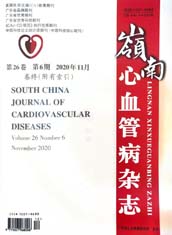作者:周铁楠;王 雅;王效增;何瑞霞;荆全民;韩雅玲
摘要:目的 比较急性和慢性降主动脉夹层行腔内修复治疗(endovascular aortic repair, EVAR)的近、远期临床疗效。方法 分析沈阳军区总医院2002年4月至2014年12月的456例(急性期342例,慢性期114例)诊断为降主动脉夹层,并行EVAR治疗的患者的临床特点及手术参数,并对术后近、远期临床随访结果进行对比分析。同时,分析降主动脉夹层患者的临床特征与术后死亡的关系。结果 与慢性期比较,急性期患者在前胸及后背部症状、入院收缩压、入院心率、胸腔积液、肾功能不全、D-二聚体(>0.5 ng/mL)的患者比例显著升高,差异均具有统计学意义(P均<0.05)。两组间EVAR相关参数比较,差异均无统计学意义(P>0.05)。术后近期结果(术后30 d内):两组间全因病死率、主动脉源性死亡、内漏、截瘫、再发夹层、主动脉破裂、肾功能不全患者比例比较,差异均无统计学意义(P>0.05)。远期随访结果(术后30 d以后):两组间病死率、内漏、再发夹层、主动脉破裂的患者比例比较,差异均无统计学意义(P>0.05)。Logistic回归分析显示入院胸腔积液(OR=39.793;95%CI:12.540~126.269;P<0.001)、冠状动脉粥样硬化性心脏病(冠心病)(OR=4.724;95%CI:1.921-11.617;P =0.001)与EVAR术后死亡存在独立相关性。结论 EVAR治疗 Stanford B型主动脉夹层安全有效,但是急性期病患术后近期病死率较慢性期具有增高趋势,两组间远期病死率相近;胸腔积液、冠心病为EVAR术后死亡的独立危险因素。 关键词:降主动脉夹层;急性期;慢性期;主动脉腔内隔绝术;病死率 中图分类号: R543.1+6 文献标志码:A 文章编号:1007-9688(2016)04-0000-00 Comparison of clinical outcomes between patients with acute and chronic Stanford type B aortic dissection treated with endovascular aortic repair in a single center ZHOU Tie-nan, WANG Ya, WANG Xiao-zeng, HE Rui-xia, JING Quan-min, HAN Ya-ling (Department of Cardiology, Institute of Cardiovascular Research, General Hospital of Shenyang Military Region, Shenyang 110016, China) Abstract: Objectives To analyze the differences inof early and long- term clinical outcomes after endovascular aortic repair (EVAR) for patients with acute versus and chronic Stanford type B aortic dissection. Methods: From April 2002 to December 2014, a total of 456 patients with Stanford type B aortic dissection were treated with EVAR in General Hospital of Shenyang Military Region. These patients were divided into two groups depending on the onset time that: acute group was within 14 days of onset (n=342) and chronic group was beyond over 14 days (n=114). Clinical characteristics, procedural characteristics and, the early and late long-term outcomes in follow-up were analyzed. Relation of clinical characteristics and death mortality after operation in patients with Stanford B aortic dissection was also analyzed. Results There was no statistical difference between acute group and chronic group in clinical characteristics including age, gender, comorbidities, metastatic pain, hypertension, state of consciousness and procedural characteristics including diameter of aortic arch, the incidence of single tear of aorta, the length of lesion to left subclavian artery, stent parameters and the coronary artery characteristics (P>0.05). However, compared with chronic group, acute group were higher in D-dimer (>0.5 ng/mL), chest or back pain, pleural effusion, acute renal insufficiency, pulse and, systolic blood pressure in hospital (P<0.05). In follow-up of 30 days, compared with chronic group, the all-cause mortality, aortic-related mortality and aortic-related complications (endoleak, paraplegia, redissection, aortic rupture and, acute renal insufficiency) had no statistical difference in the two groups in early and late ong term (P>0.05). Pleural effusion and coronary artery disease could predict mortality after EVAR (OR=39.793; 95%CI: 12.540-126.269; P <0.001; OR=4.724; 95%CI: 1.921-11.617; P=0.001). Conclusions There wais no statistical difference in mortality of Stanford type B aortic dissection treated with EVAR in early and long-term follow-up, whereas the early mortality wais higher in acute group. Pleural effusion and coronary artery disease were are the independent risk factors of mortality after EVAR. Key words: aortic dissection; acute; chronic; endovascular aortic repair; mortality
PDF下载:下载地址








